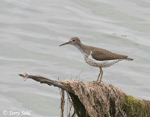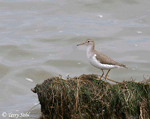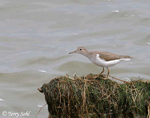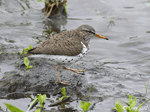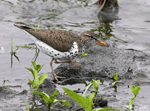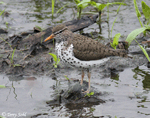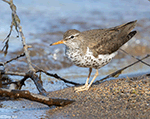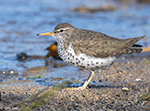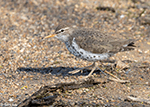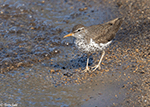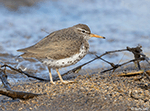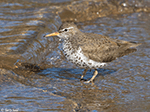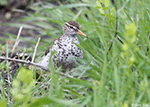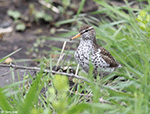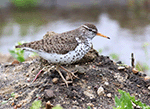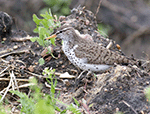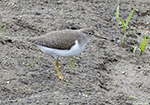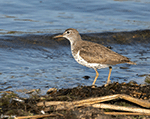| Length: 7.5 inches | Wingspan: 14 inches | Seasonality: Summer |
| ID Keys: Large round spotting on breast (summer), white eyebrow, short straight bill. | ||
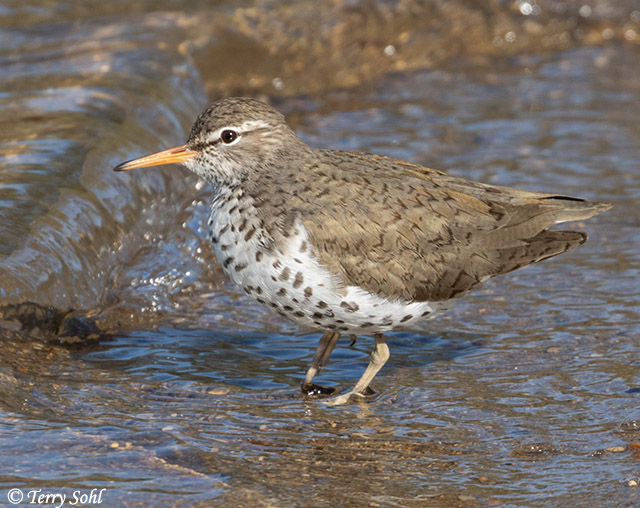 One of the most widespread
and common of the Sandpipers, the Spotted Sandpiper can be found teetering along
shorelines and riverbanks throughout the state. They are generally found singly,
very rarely in large groups. It has a habit of constantly bobbing its rear end
up and down. Wintering grounds include the coastlines and
southern portions of the United States all the way through southern South
America.
One of the most widespread
and common of the Sandpipers, the Spotted Sandpiper can be found teetering along
shorelines and riverbanks throughout the state. They are generally found singly,
very rarely in large groups. It has a habit of constantly bobbing its rear end
up and down. Wintering grounds include the coastlines and
southern portions of the United States all the way through southern South
America.
Habitat:
Spotted Sandpipers can be found in a wide variety of aquatic habitats in the state, including the shorelines of lakes, ponds, and rivers, small riparian streams, and flooded ditches and fields.
Diet:
Large numbers of insects, also crustaceans, mollusks, small fish, earthworms, and occasionally carrion.
Behavior:
Uses a wide variety of foraging techniques, most often plucking food items from the water's surface or the ground. Very seldom flocks with others of the species, usually found alone or in pairs. When found foraging on the shoreline or near water, they will often walk or run for a short stretch before pausing, bobbing their tail up and down. They will often initially run away when a perceived threat approaches. When they do take flight, they have a characteristic very rapid, shallow wingbeat flight pattern.
Nesting:
Late May through early July in South Dakota. Courtship between Spotted Sandpiper pairs may consist of short displays, with wings fanned in front of the potential partner. Mock nest-building activities also typically occur, with a number of sites explored and partial nests constructed before the final nest site is selected. The nest itself is typically placed in the cover of a small shrub or other vegetation that provides some shelter and protection, typically relatively near water. It consists of a shallow scrape, lined with grasses and bits of wood. It is the male that incubates the eggs, with the young hatching after about 20-23 days. The male also cares for the young without assistance from the female. Females may mate with multiple males during the breeding season.
Song:
Interactions among Spotted Sandpipers are often accompanied by a string of tsweet calls, given in rapid succession. They also have multiple call and alarm notes of one syllable.
- Click here to hear the repetitive tsweet calls of a Spotted Sandpiper1
- Click to hear short call notes of a Spotted Sandpiper2
Migration:
Summers throughout much of the United States and Canada. Winters along North American coasts, the extreme southern United States, down through much of South America.
Interactive Ebird Map:
Click here to access an interactive eBird map of Spotted Sandpiper sightings
Similar Species:
Spotted Sandpipers could potentially be confused with some other yellow-legged sandpiper/shorebird species that are found in South Dakota, particularly during migration.
- Solitary Sandpiper - Solitary Sandpipers are migrants in South Dakota, so time of year is one clue, as Spotted Sandpipers are the only species on this list that stay and breed in the state in the summer months. They are perhaps the most similar shorebird species in appearance to a Spotted Sandpiper, but they are easily differentiated if seen well. Solitary Sandpipers have a brown back with the appearance of small white spots, while Spotted Sandpipers have a more uniformly brown back with some darker markings interspersed. The underside of a Solitary Sandpiper is white, with brown markings on their breast and throat. On a Spotted Sandpiper in breeding plumage, the underside is white with large brown spots. The eye ring on a Solitary Sandpiper is more prominent than the one on a Spotted Sandpiper. It becomes more difficult to distinguish them in non-breeding plumage, as the Spotted Sandpiper loses its spotting underneath and more closely resembles the Solitary Sandpiper. Back markings, eye ring, and the taller stature of a Solitary Sandpiper still distinguish the two species in non-breeding plumage.
- Lesser Yellowlegs - Another "yellow-legged" sandpiper and one of the most common shorebird species that migrates through the state, the two species are easily differentiated if seen well, as Lesser Yellowlegs are a larger species with noticeably longer legs, have a longer, thinner bill, and a lack of the spotting underneath that is characteristic of a breeding plumaged Spotted Sandpiper. They could perhaps be confused when the Spotted Sandpiper is in non-breeding plumage, given the lack of spots. However, in addition to the characteristics noted above, the more complex back markings of a Lesser Yellowlegs contrast with the more uniform brown upperparts on a non-breeding Spotted Sandpiper.
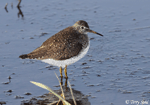 |
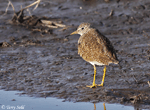 |
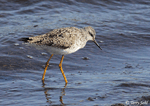 |
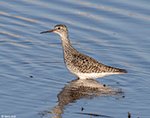 |
| Solitary Sandpiper | Solitary Sandpiper | Lesser Yellowlegs | Lesser Yellowlegs |
Conservation Status:
Spotted Sandpipers are found a very broad geographic region and are common in many parts of their range, although surveys in recent decades have shown small declines in overall populations. However, there are no serious current threats to the overall population, and the IUCN considers the Spotted Sandpiper to be a species of "Least Concern".
Further Information:
Photo Information:
May 27th, 2013 -- Minnehaha County -- Terry Sohl
Additional Photos:
Click on the image chips or text links below for additional, higher-resolution Spotted Sandpiper photos.
Audio File Credits:
- 1Ian Cruickshank. Recorded near Vancouver Island in British Columbia, Canada on June 24th, 2014. Original recording and information from xeno-canto.
- 2Paul Marvin. Recorded in Starr County, Texas on December 19th, 2017. Original recording and information from xeno-canto.
| Click on the map below for a higher-resolution view |
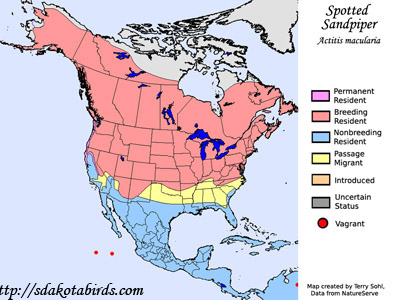 |
| South Dakota Status: Common migrant and uncommon summer resident in suitable habitat across the state. |
Additional Spotted Sandpiper Photos
Click for a higher-resolution version of these photos
